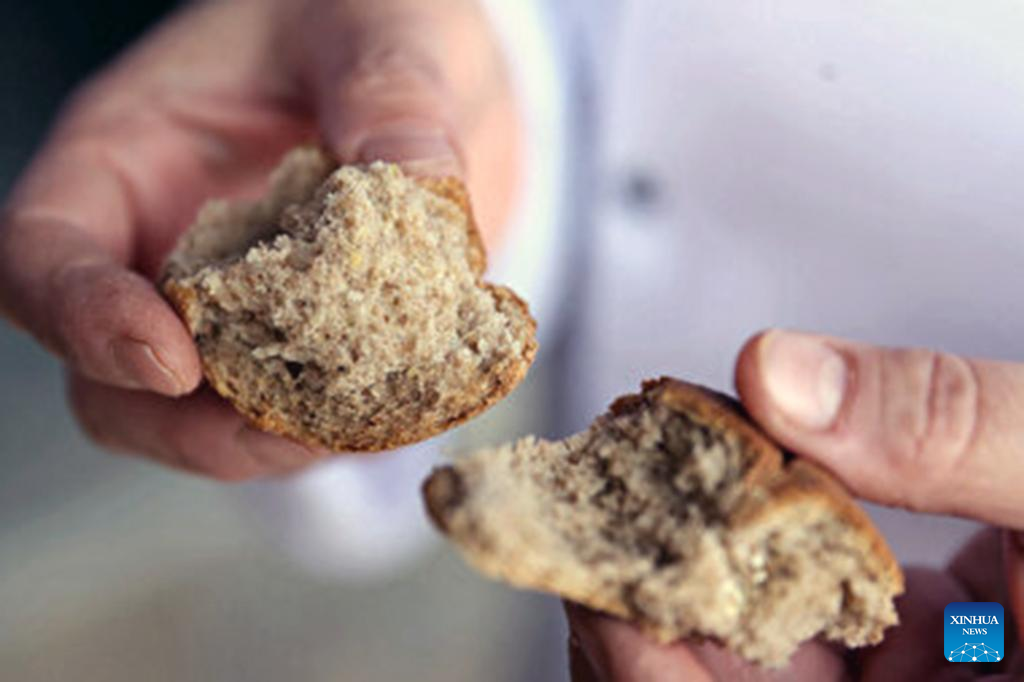
Loaves of bread remade with the same ingredients that Neolithic people used is pictured in Konya, Türkiye, on Jan. 21, 2025. (Mustafa Kaya/Handout via Xinhua)
by Burak Akinci
ANKARA, Jan. 23 (Xinhua) -- A Turkish chef said he has resurrected a bread inspired by 8,600-year-old Neolithic remains discovered during archaeological excavations in an ancient settlement site in south-central Türkiye.
Ulas Tekerkaya, a chef passionate about food archaeology and author, recreated the loaf with the same ingredients that Neolithic people who settled millennia ago in Catalhoyuk, one of the oldest known cities in the world, located in central Türkiye's Konya province.
In March last year, archaeologists announced the discovery of a large communal oven-like structure at the site. Inside, they found traces of food, including the palm-sized spongy, burnt object that is believed to be bread.
Analysis at the Science and Technology Research Center of Necmettin Erbakan University (BITAM) confirmed the grain composition of the leavened bread included ingredients like peas, barley, and wheat.
Archaeologists at Anadolu University in central Türkiye said the finding is "a bread that is approximately 8,600 years old."
Inspired by the interesting find, Tekerkaya decided to replicate the long-lost recipe of the loaf using grains, seeds and flower extracts primarily found and grown in the region.
After several attempts, he shaped the dough into balls and baked them over a wood fire at the Meram City and Life Culture Museum in Konya earlier this month.
"On my first try, the bread was very bitter and hard. Therefore, I realized that I had not fully complied with ancient rules," he told Xinhua in a recent interview.
"After nearly a year of painstaking experimentation, I finally managed to replicate identically the bread that the ancient people of Catalhoyuk used to cook and eat," he explained.
He added that Neolithic people ate the bread as a whole meal with very few other things on the side.
In the ancient world, bread was a staple, providing 50 to 70 percent of daily caloric intake. However, questions remain about what defines bread and who first created it.
The invention of bread was closely linked to the shift from hunter-gatherer societies to agriculture, which scientists believed took place during the Neolithic era. Catalhoyuk is frequently regarded as a prime example of the critical shift to agricultural society.
Tekerkaya, author of "Catalhoyuk, a 10,000-year-old Food Culture," is a native of Konya and a fervent adept of all things Neolithic.
It took Tekerkaya more than seven years to compile and analyze a comprehensive repertoire of discoveries related to nourishment habits from the Neolithic period to write the book, which led him to replicate many dishes.
"I have prepared up to now 35 dishes of this period, including a hedgehog ragout and a lizard meal," he indicated.
According to BITAM, Catalhoyuk, a UNESCO World Heritage site, was home in its heyday to over 8,000 people during the Neolithic period, spanning from around 10,000 BCE to 2,000 BCE, and is considered one of the earliest examples of urbanization in the world.
Uncovered in the early 1960s, Catalhoyuk gained global recognition for its significant size and remarkably preserved structures. People lived in tightly packed mudbrick houses, using their rooftops for socializing and daily activities.
The residents of the area were among the earliest farmers, cultivating crops like wheat and barley while raising sheep and goats. ■

A person shows bread remade with the same ingredients that Neolithic people used, in Konya, Türkiye, on Jan. 21, 2025. (Mustafa Kaya/Handout via Xinhua)



